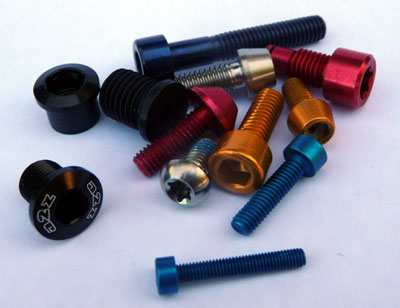Bolt tuning is all about replacing heavy steel bolts with titanium and aluminum to save weight without adversely affecting the safety or longevity of your ride. Nino's article from 2002 indicated that bolt tuning could save you around 150g. That article was in relation to v-brakes, but similar weight savings are availble through tuning the bolts associated with disc brakes as well. See for example tuning the Hygia SLPs where bolt tuning saves almost 40g.
About bolts
Bolts are classified by reference to their "tensile ultimate strength" and their "tensile yield strength". The ISO standard gives us a number of property classes: 4.6, 4.8, 5.8, 8.8, 9.8, 10.9, and 12.9. For more information have a look at the wikipedia article on screws .
Bolt threads can either be machine cut or rolled. In general, rolled threads will be stronger and prone to fatigue.
High tensile bolts
High tensile bolts will often have their strength class stamped on their head: 8.8, 9.8, 10.9, and 12.9. Anything over 8.8 is not suitable for replacement with anything other than the same (or higher) class of bolt.
Titanium bolts
About titanium bolts
Titanium bolts come closest to steel in terms of strength but Ti is 47% lighter.
Note, although Ti bolts can be as strong as mild steel bolts,they are no substitute for high tensile steel bolts. Syntace sell some high quality Ti bolts and here is what they say about high-tensile bolt replacement:
- Syntace titanium bolts are no substitute for bolts above 8.8 strength - recognizable through stampings of “10.9” or “12.9” on the screw head. If in doubt you have to assume that titanium bolts are NOT suited for the application to ensure your own safety.
Accordingly, if you need to replace 8.8 strength bolts, then make sure you are using the strongest and best Ti bolts you can get. DO NOT replace 10.9 or 12.9 bolts with Ti. The most common places to find high-tensile bolts on your bicycle will be holding the suspension pivots together.
Ti bolt applications on your bicycle
High quality Ti bolts can be used in the following areas:
- disk brake rotor bolts;
- caliper mounting bolts;
- seatpost saddle rail clamp bolts;
- frame/fork v-brake/cantilever brake bosses;
- stem clamp bolts; and
- any other areas where the strength of steel is needed.
Aluminum bolts
Aluminum bolts are weaker than mild steel. Use them where strength isn't important, such as:
- front and rear derailleur pinch bolts and cable bolts;
- rear derailleur jockey wheel bolts;
- shadow rear derailleur pivot bolt;
- front and rear derailleur limit adjust bolts;
- brake and gear shifter lever pinch bolts;
- aheadset tension bolt;
- bottlecage bolts;
You can also use aluminum for chain ring bolts - although weaker than the steel you are replacing, the large diameter of chain ring bolts means that aluminum is suitable in this case. Significant weight savings are availble of around 30g on a triple chainring crankset.
Carbon bolts
Carbon bolts are about half the weight of aluminum bolts. You can use carbon bolts most places aluminum bolts work, but carbon bolts are probably weaker than aluminum in the size range that you need to use. The problem with the carbon bolts is that there may not be any carbon fibre in the threads or that the fibres are cut by the thread making process in which case the threads are just relying on the epoxy for strength.
Nylon / plastic bolts
Similar weight to carbon bolts, so about the half the weight of aluminum bolts, but much cheaper than carbon. Nylon bolts are not strong, so they can only be used in places where the bolt force required is minimal.
Nylon bolts don't sound very exotic or particularly high-tech, but there are certain places where they can be used:
- derailleur stop screws;
- brake lever clamp bolts - you will need a brake lever that only has the one pinch bolt . Most of the force of these types of levers is taken by the body of the brake lever - the pinch bolt really just holds things together. Brake levers are often best setup so they can rotate if you crash so they don't need to be clamped on particularly tight. Nylon is not suitable if your brake lever has a removable clamp - all the force on these designs in taken by the bolt threads.
Bolt tuning articles
Notes
- Aluminum bolts are very much weaker than steel and titanium when subjected to shear forces.
- Titanium bolts can be as strong as mild steel or stainless steel bolts. Titanium bolts are not as strong as high-tensile steel bolts.
- Don't be an idiot - use this bolt tuning guide at your own risk. If you are not 100% sure that a ti or alu bolt will not work then DO NOT replace the stock bolt. Bolt tuning is only saving you a handful of grams so its not worth doing anything risky for slight small savings (indeed, even if the savings were massive it would not be worth risking physical injury).
